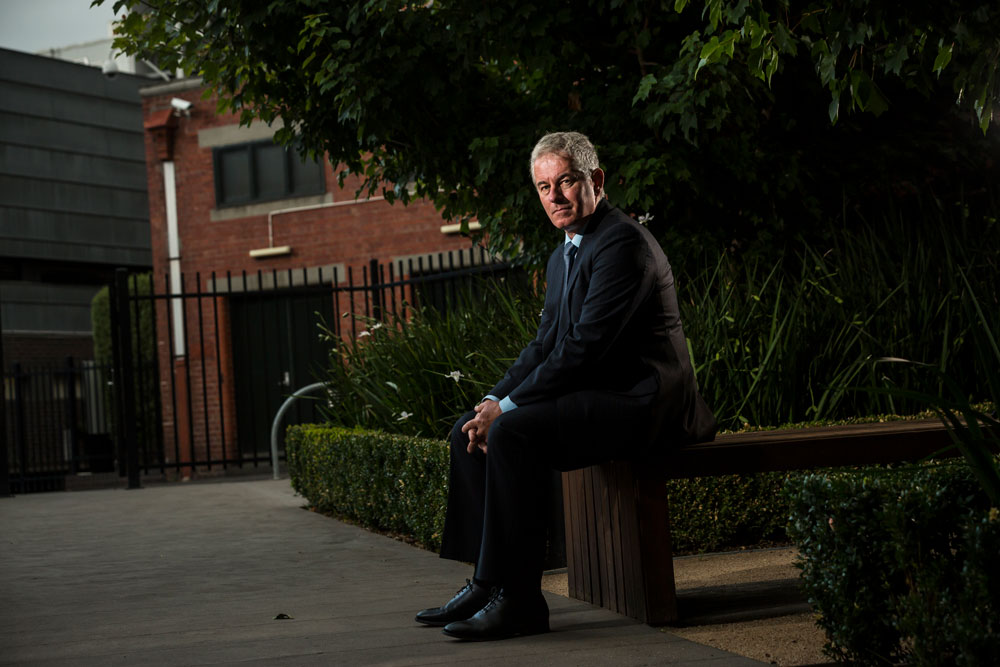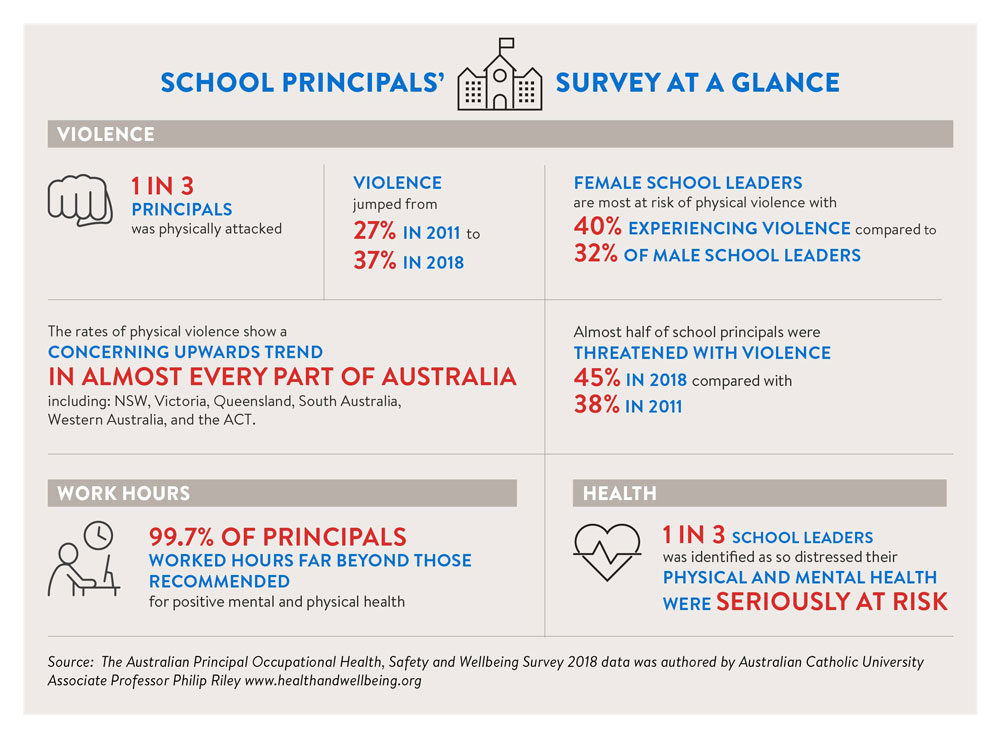Physically attacked, stressed and depressed: Australia’s school principals speak out in new survey

Associate Professor Philip Riley, from Australian Catholic University’s Institute of Positive Psychology and Education. Photo: Chis Hopkins.
One in three Australian school principals was physically attacked and one in two experienced threats of violence at work, according to a new survey released on Wednesday, Feb 27.
In a worrying trend, almost half of school principals (45%) were threatened with violence in 2018, compared with 38% in 2011. The survey also found that increasing threats and violence, aggravated by excessive working hours, are leading to serious levels of distress, burnout and depression among school leaders.
Now in its 8th year, The Australian Principal Occupational Health, Safety and Wellbeing Survey, has collected data from about 50% of Australia’s 10,000 principals from 2011 to 2018. Australia’s principals are overwhelmed by the volume of work; being threatened with violence; being physically attacked, having great difficulty sleeping; and experiencing high rates of depressive symptoms.
Associate Professor Philip Riley, from Australian Catholic University’s Institute of Positive Psychology and Education and the survey’s chief investigator, said, “Clearly, our nation builders are under attack. Consequently, fewer people are willing to step into the role. At a time when 70% of school leaders will reach retirement age within 2-3 years, we are ignoring a looming national crisis.”
Causes of Stress
The survey found the sheer quantity of work and the lack of time to focus on teaching and learning were the greatest sources of principals’ stress. Teacher shortages were also a frequent issue.
An increasing source of stress is managing the mental health issues of staff and of students.
Work hours
- The standard working week in Australia is an average of 38 hours.
- 53% of principals worked more than 56 hours per/wk, during term.
- Approximately. 24% of principals, or 1 in 4, worked more than 61-65 hours per/wk.
- During school holidays, approximately 40% of principals worked more than 25 hours per/wk.
- The survey found an overwhelming 99.7% of principals worked hours far beyond those recommended for positive mental and physical health.
Violence
- One in three principals was physically attacked in 2018.
- Violence jumped from 27% in 2011 to 37% in 2018.
“Australia’s school leaders experience a far higher rate of offensive behaviour at work than the general population,” Associate Professor Philip Riley said.

Female school leaders are most at risk of physical violence with 40% experiencing violence compared to 32% of male school leaders. The rates of physical violence show a concerning upwards trend in almost every part of Australia including: NSW, Victoria, Queensland, South Australia, Western Australia, and the ACT.
Threats of violence
- The highest number of threats of violence is found in government primary schools at 49%.
- The lowest prevalence of threats is in P/K – 12 Independent schools at 12% (this is still 1.5 times the population rate).
Associate Professor Philip Riley said, “The steadily increasing levels of offensive behaviour in schools of all types is a disgrace and it needs to stop.”
Health
One in three school leaders was identified as so distressed that their physical and mental health were seriously at risk.
When compared to the general population, principals report 1.5 times higher job demands,
1.6 times higher levels of burnout, 1.7 times higher stress symptoms, 2.2 times more difficulty sleeping, 1.3 times negative physical symptoms and 1.3 times more depressive symptoms.
Key recommendations
“Australia should adopt a whole-of-government approach to education,” Associate Professor Philip Riley said. “This would mean the federal government, states and territories combine to oversee a single education budget. The funding agreement should be bipartisan and a transparent mechanism which is simple to understand.”
Other recommendations include:
- Employers should reduce job demands or increase resources or do both.
- The community needs to immediately stop offensive and violent behaviour towards educators.
- Australia also needs to have adult conversations about the root causes of this violent behaviour, which is occurring in all frontline professions and in the high rates of domestic violence.
- School leaders should not allow their passion for their school to dominate their life.
The full survey and its 15 detailed recommendations are available here.
Source: Australian Catholic University



I am not in the least surprised by the Survey results. As a former secondary school teacher who ‘retired’ from the job almost two decades ago, I can testify to the negative attitude shown by some parents to the results their children receive. It was always the teachers’ fault or they can’t teach! It was rarely accepted that their child was disruptive or lacked motivation. Worse, these days it is politically incorrect to point it out in Semester Reports!
The level of family disfunction/violence was a concern to me back then. Heaven knows what it is like now. Many parents both work, children are left “home alone” and unsupervised after school. Homework is not done.
It is well and truly time that politicians accepted that the level of dysfunction in families and our society in general has reached an unacceptable level. Instead of attacking teachers for poor results, we need to examine why this is happening. For example NAPLAN was the dumbest idea our leaders could have dreamed up. Having seen a similar “learn to the test” regime in the UK, with the negative outcomes there for teachers and schools,I was aghast when it was introduced here.
We need to support and affirm our education leaders and classroom teachers, otherwise there will be a staffing crisis very soon.
This study is about school principals, I would love to see a real honest survey given to teachers about what they really think at the coal face! Often we don’t even have a voice!